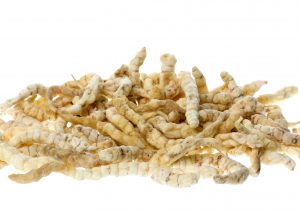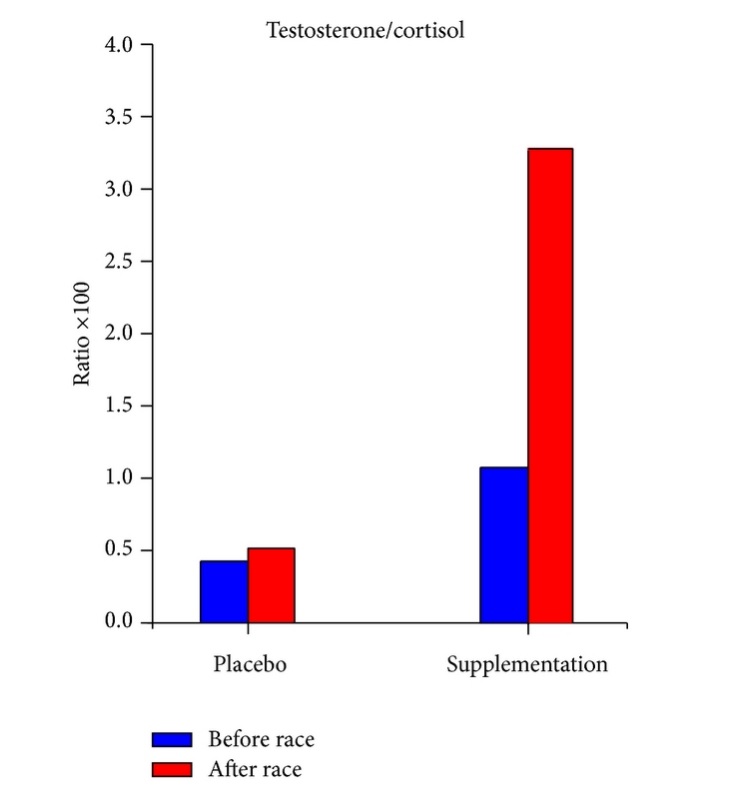Edible fungus may enhance male athleticism by regulating sex hormones & reducing free radicals.

Viewed in China as a longevity-promoting mushroom, Cordyceps is a traditionally rare fungus that (yes) grows on the backs of caterpillars before being consumed (with the caterpillar). The fungus’ interaction with T-production & its mild adaptogenesis may help men achieve better athletic functioning through these key bio-activities:
- T-synthesis regulation. Cordyceps may either increase or decrease T depending on the body’s homeostatic needs.
- Oxidative stress reduction. Limiting free radicals is important not only for T, but for male & female health in general.
- Potential ergogenic aid. One study says ‘yay.’ Another says ‘nay.’ Cordyceps’ ergogenesis might depend on the type of exercise.
Overview
Traditionally grown in China & other Asian regions on caterpillar bodies, Cordyceps encompasses a variety of parasitic “insect-killing” sac-fungi–a few of which are consumed as vitality enhancers:
- Cordyceps sinensis
- Cordyceps militaris
- Cordyceps kyushuensis
For centuries, these fungi were inaccessible to most of the world, due to their hard-to-reach locations in the high altitudes of the Tibetan & Sikkim mountains. During those times, Cordyceps was used to treat upwards of 21 different ailments1–but, for men, the effectiveness of Cordyceps remedies seem to hinge on only one of its potential bio-actions:
Boosting testosterone.
As the rest of the world is learning up on this long-held Tibetan secret, more & more supplement manufacturers are getting the jump on research by including Cordyceps in their T-booster stacks… But is this a smart move or is the T-boosting world jumping the gun on this one?
![By Bernard DUPONT from FRANCE (Ant Killed by Fungus) [CC BY-SA 2.0], via Wikimedia Commons](https://supplementsinreview.com/wp-content/uploads/2016/07/Ant_Killed_by_Fungus_-_Cockscomb_Wildlife_Sanctuary_Belize.jpg)
How Cordyceps Might Help T
Activates StAR pathway
One of Cordyceps primary active constituents, Cordycepin, is believed to upregulate the StAR (steroidogenic acute regulatory) enzyme, which helps transport cholesterol into the mitochondria for metabolism into testosterone. Regulating the StAR pathway can greatly alter the rate of T-synthesis by trafficking the flow of raw T material–thus giving Cordycepin more of a regulatory role on T, instead of outright boosting the sex hormone.2
Reduces oxidative stress
There’s a well-documented negative link between oxidative stress & T levels (in addition to other markers of male sexual health).3 This is important for exercising men who are at-risk of excessive, harmful levels of oxidative stress (i.e. free radical accumulation) that can induce counter-productive catabolic conditions on muscle, strength, & testosterone. However, Cordyceps has been shown to decrease levels of oxidative stress under conditions of high-intensity exercise.
SiR Recommendation: Between Cordyceps sinensis and Cordyceps militaris, go for the sinensis species, which seems to offer slightly more antioxidant protection than militaris.4
Increases estrogen?
This doesn’t help T, does it? No, it doesn’t. However, Cordyceps Militaris supplementation has been shown to increase estradiol levels in rats after 2 weeks of supplementation. By week 4, estradiol levels were back to baseline levels, highlighting Cordyceps role as a “regulator” again, rather than an outright booster. Fortunately, this doesn’t seem to pose any serious threat to men’s T levels as Cordyceps simultaneously increased T while increasing estradiol.5
Research
Animal Research
In terms of animal research, there’s plenty of preclinical literature on the interactions between Cordyceps and T production–particularly as they play out within the Leydig cells (site of T production).
One rat study in particular showed a positive correlation between Cordyceps Militaris (CM) supplementation and a couple biomarkers of male sexual health–spermatogenesis (sperm production) & steroidogenesis (T production). The rats were divided into three groups–regular diet, 1% CM diet, 5% CM diet–and observed over a span of 6 weeks. The results:
- Increased sperm count by 53% (1% CM) & 37% (5% CM)
- Increased sperm motility by 31% (1% CM) & 19% (5% CM)
Interestingly, both groups also showed increases in serum T levels, but the lower 1% CM dosage provided a more stable increase in T, whereas the higher 5% CM dosage greatly fluctuated over the 6 weeks.5 This may suggest that lower Cordyceps dosages are better for T than higher dosages.
Something that’s also noteworthy: Cordyceps increased estradiol concentrations, too. Estradiol being the bio-active “T-killing” form of estrogen. This seems odd considering CM’s direct benefits on male health & T production–independent of Luteinizing Hormone, Follicle-Stimulating Hormone, or Prolactin, which can indirectly affect T levels, but were unaltered by Cordyceps supplementation in this study.
This may be due to the observation that Cordyceps is more of a T regulator than T booster. Another study on mouse Leydig cells treated with forskolin, a phytochemical that induces steroidogenesis via cAMP stimulation, found that Cordyceps supplementation inhibited T-synthesis stimulated by cAMP by about 60%.7
The take-home: Cordyceps seems to conditionally boost T as part of a larger hormone regulatory function and might increase estradiol, too, under the same principle.
Human Research
But don’t take that “take-home” home, yet. We have two more studies to discuss:
Cordyceps + Ganoderma lucidum duo increased T, decreased oxidative stress for 7 male cyclists.
In a small study on the combined effects of Cordyceps + Ganoderma lucidum on athletic performance, 7 male endurance cyclists (aged between 30 & 40) took placebo for 1 month, then the fungal supplements for 3 months while having their pre-race/post-race levels of T, cortisol, & oxidative stress monitored for any changes. The T:cortisol ratio was of particular importance for its implications regarding nonfunctional overreaching (NFO) or overtraining syndrome (OTS).

- By the end of the study, the results showed that Cordyceps + Ganoderma lucidum significantly increased the T:cortisol ratio, “protecting athletes from NFO and OTS.” Additionally, a decrease in oxidative stress was observed, supporting the fungi’s use as anti-catabolic, ergogenic aids in endurance sport.8
2.4 g Cordyceps daily had no effect on T levels among resistance-trained male adults.
In another small, yet slightly bigger study, Cordyceps sinensis or placebo were administered to resistance-training male adults (n = 16) over a span of 8 weeks to observe CS’s effects on exercise-related measures of body composition, plasma T, serum urea nitrogen, creatinine, aspartate transaminoferase, & alanine transaminoferase.
- The results: “CS supplementation did not significantly affect (p>0.05) the changes in all measurable variables after eight weeks of resistance training.”9
While this seems to contradict the previous study’s finding, bear in mind the tiny sample sizes observed in both studies, as well as the remarkable differences between endurance cycling & resistance weight training. Also, while the 2.4 g Cordyceps daily dosage was shown to be safe, this doesn’t mean it’s effective. We need more research to determine the proper Cordyceps dosage for T-boosting.
Dosage Notes
- 1,000 mg – 3,000 mg daily
- Either as a single dose or split into multiple daily servings
Supplements typically provide Cordyceps within the 500 mg – 1,000 mg dosage range, allowing plenty of room for manipulation of daily intake–however, human research has yet to identify an optimal range of daily Cordyceps dosaging. Judging by the animal studies, it would seem that lower dosages are better at sustaining T, but, again, this needs to be justified by clinical research.
Side Effects
For the most part, Cordyceps are SAFE, backed by a “sub-acute toxicity” rat study that observed no side effects with Cordyceps supplementation of up to 2 g/kg body weight.10 However, under conditions or risk of auto-immunity, men & women are advised to take caution with Cordyceps due to the fungus’ ability to increase activity of the immune system.11
Available Forms
![By Lamiot (Own work) [GFDL or CC BY-SA 3.0], via Wikimedia Commons](https://supplementsinreview.com/wp-content/uploads/2016/08/ElaphomycesGranulatusCordycepsAntonKerner-202x300.jpg)
In terms of supplementation, Cordyceps’ form can range from:
- Plain Cordyceps. Raw, dried & ground Cordyceps–typically in a capsule or tablet. Offers the most basic, least bioactive samples.
- Cordyceps Extract. Widely varies in composition, making almost every extract unique. Cordyceps extracts seem to have “luck of the draw” bioactivity–some are good, some are inefficient.
- Standardized Cordyceps. More stable range of bioactivity. Cordyceps standardized to 10% cordycepic acid is a common extract in premium Cordyceps products.
Supplements in Review Recommendation
- Cordyceps standardized to 10% cordycepic acid, 1,000 mg – 3,000 mg daily
Start small, then (maybe) go big. Cordyceps research has a few glaring holes–namely in the dosage department. If the animal studies are any indication, then lower dosages have a stronger, more stable range of benefits than the higher dosages. Plus, it’s a simple matter of “assessing the risks” before diving in full-bore. On that note, stay tuned in on Cordyceps research for the latest developments on how to supplement this T-booster, and stayed tuned here for the latest on T-boosters in general.
Research
Perhaps the E increase is due to an increase in aromatase enzyme?